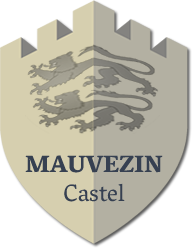Centule The First
Centolh V, Viscount of Béarn reigned from 1058 AD until his death in 1090 AD
Centolh V (or Centulle V in French) was Viscount of Béarn and was first a vassal of the Duke of Aquitaine Guju-Jaufré, then of his successor Guilhem IX, with whom he maintained good relations.
He helped them both during several military campaigns and obtained several holdings in return including the Viscounty of Acqs along with the lands of Orthe and Salies. Most importantly, he was released from any oaths of fealty, a rare freedom that the Béarnese people would seek to preserve.
Centolh understood that power was best consolidated by official enactments and decrees, so he commissioned several “fors et coutumes” (city charts). These statute-books covered both private and public rights and were similar to the ones already commonly used in the Iberian Peninsula. Several of these “fors” were created, such as the ones in Oloron and Morlaàs. He also minted his own coin, the Centule.
Centolh V became Count of Bigorre and built Mauvezin’s first keep
Centolh V was an important figure in the history of Mauvezin Castle, since he’s probably the one who started its construction.
In 1079 AD Centolh was forced by Pope Gregory VI to repudiate his wife Gisla (or Gisela) with whom he shared a closeness of kinship that prohibited them from marriage. With her he fathered 3 children: Gaston IV, Raimon Centolh and a daughter, Osquineta (Osquinette).
He built a church in Morlaàs and gifted it to Cluny to make amends for his sins. He also married Beatrix (or Beatrice) of Bigorre the same year, becoming Count of Bigorre under the name Centolh I or Centule the 1st.
Motte-and-bailey castles were built at several key strategic locations within his new domains, including Mauvezin. The motte-and-bailey castle, called casterar in Gascon, was the precursor of the traditional medieval keep or casteràs. It usually consisted of a wooden tower built upon a natural or artificially raised earthwork surrounded by a ditch and a protective fence. The purpose of this tower was primarily defensive.
Did this reflect a will to resist the influence and power of the Dukes of Aquitaine in the West, or was it simply an effort to reinforce the area’s defensive capability? No one knows for sure to this day.
Béarn, Aragon and Bigorre
While Centolh distanced himself from Aquitaine, he focused his attention even more towards the Kingdom of Aragon by becoming vassal to its King. He married his son and heir to Talesa of Aragon and engaged in many battles in the lands on the other side of the Pyrenees. He took part, although unsuccessfully, in the siege of the city of Zaragoza (Saragossa in Spain) held at the time by Rodrigo Diaz de Bivar (best known as “El Cid”) on behalf of the Muslims.
Centolh was assassinated in Tena in 1090 AD while on his way to join the siege of Huesca.
Upon his passing, his lands and titles were split in two: his son Gaston IV became Viscount of Béarn and would often be seen on the side of King Alfonso I of Aragon “The Battler” during the Spanish Reconquista. His wife Talesa handled his affairs in Béarn during his absence.
Centolh’s wife, Béatrix (Beatrice) of Bigorre reigned as regent in Bigorre where she would smash the peasant revolt in Barèges. Her two sons from a second marriage, Bernat III (or Bernard III) and Centolh II (or Centule II) reigned consecutively as Counts of Bigorre.







